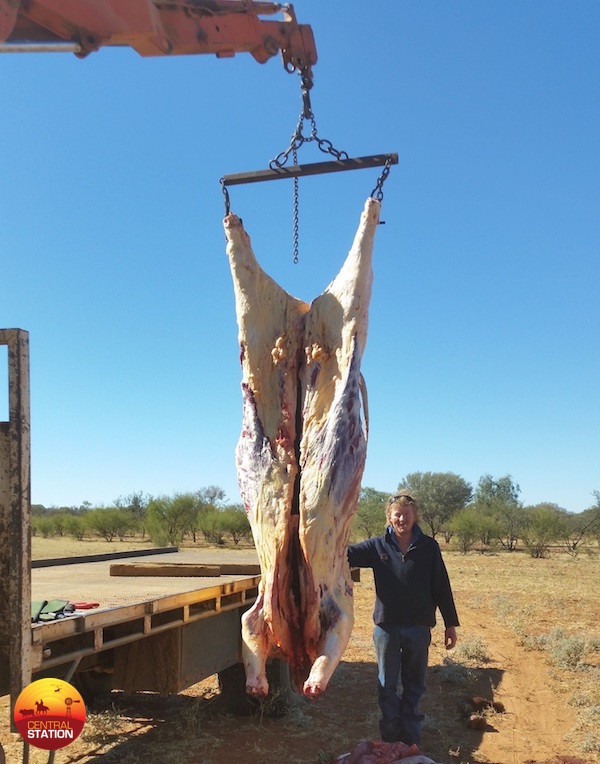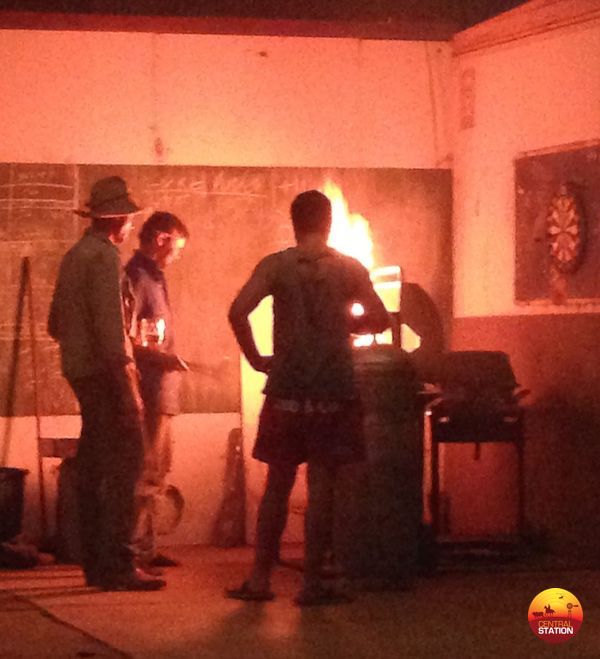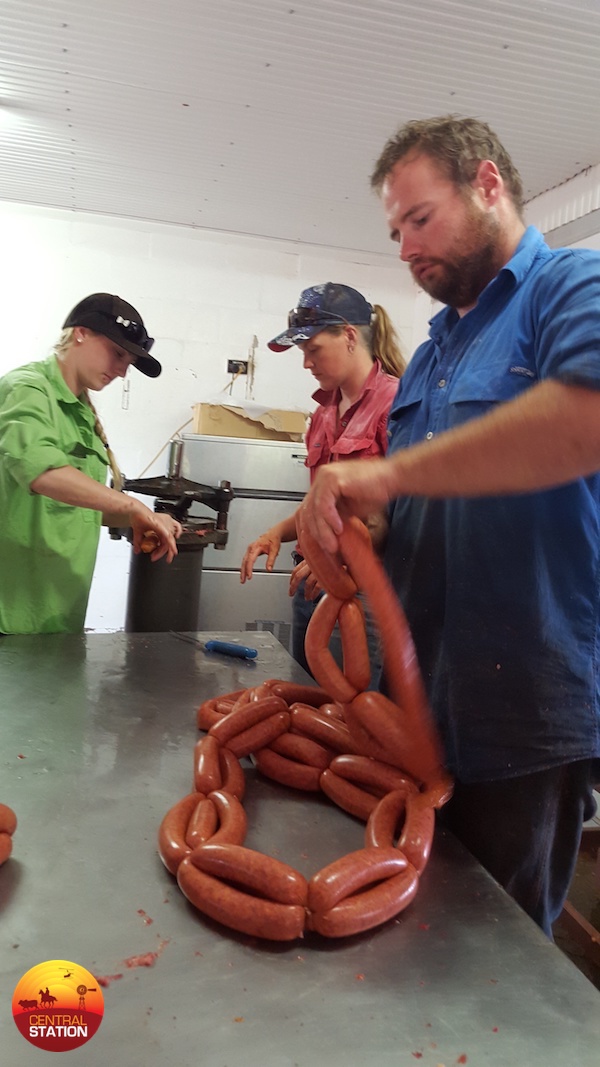Bones are for dogs
Host: Kadiaitcha Pastoral Company
Written by James Christian – Owner, Kadiatcha Pastoral Company.
We’ve had a busy time at Napperby recently. So busy, in fact, that we ran out of meat in the cool room. Usually we would have another beast hanging as the shelves get bare, when only mince or the suspicious off-cuts plainly labelled “steak” are left behind, but with the priorities being what they were, the unthinkable happened – the cattle station ran out of beef.
The process for restocking the meat shelves is fairly simple, methodical, and obvious. Shoot the target, bleed it out, skin it, gut it, quarter it, hang it in the meat house, cut it up a week or so later, and enjoy the compliments on the tastiness and “melts in your mouth” comments, or get cross about the “Flavourless and by Christ it’s chewy!” jibes that will inevitably be thrown your way, as if you were personally responsible for letting the good qualities escape.
If you bush roll them, you skin them on one side, take the juicy, choice cuts, fold the skin flap back, roll the beast over, and repeat the process before the ants come marching in. Some people can do it before the billy has boiled . . . but certain circumstances breed speed!
Suffice to say I wasn’t very fast at either the slaughtering or butchering when doing my first killer. Learning a new skill is like learning your way around a place – it comes with time, and it comes with doing it yourself. Sitting in the passenger seat tends to send you to sleep as you’re chauffeured around; watching someone do something gives you pointers; doing it yourself makes it sink in. The wise man Confucius, when he studied butchery, concocted the saying “I hear, I forget. I see, I remember. I do, I learn.” No doubt Confucius was subsequently faster when he got the nod next time.
At Napperby we have the benefit of some good plant and other infrastructure. A gambrel can be hung from the backhoe loader bucket, there is a dedicated meat chainsaw, and our meat house has long rails that extend from outside into the cool room. The hardest part of the operation is choosing whose ute tray to clean up for the purpose of transporting the quarters. Sometimes we use a tarp, but the best thing is freshly harvested gum tree branches and leaves laid out on the back.
 Skid with a monster. This bloke dressed at 620kg.
Skid with a monster. This bloke dressed at 620kg.
I’m not one for offal. I was born in the 1980’s, and as such missed out on the lessons of the Great Depression. Don’t get me wrong, steak and kidney pie is nice, and so is heart rolled in flour salt and fried up. But I would rather eat muscles than organs. I recall as a child being in my grandparents’ house in the eastern suburbs of Sydney, smelling something strange coming from a pot on the stove in the kitchen, where something was lolling around in boiling water. “What’s that?” I asked.
“Tongue,” said my grandmother, “for lunch.”
“Yuck!” I exclaimed, backing away.
“What? You don’t eat tongue?” huffed my grandfather, obviously somewhat chagrined. “More for us then, it’s delicious.”
Much to the vexation of the Argentine backpacker, Jorge (“No no, you pronounce Horrrrrhey, Horrrrrhey, with the rrrrr!”), I didn’t keep any of the offal with the last killer. In Argentina, it seems, they eat everything but the eyelids and the tail hair. “Oh, yeeees, we keep de kidney, de leever, de hart. Dis one, how you say, tripa de leche, eentestin for milk?”
Obviously loads of people cook up the milk gut. Beef cheek is a trendy dish in city restaurants. Some people bang on about oxtail soup, and there are those who enjoy testicles, sweetbreads, and brains. As I said, steak is the stuff for me. Rump is one of my favourites, oyster blade is up there, topside is good for biltong, and porterhouse and New York cuts are very tasty. In the same way that Philips head screwdrivers are for Philips head screws, boning knives are for boning. I realise this may be a point of difference between me and the readership, but I don’t like bones. I don’t froth over the prospect of gnawing on ribs, I don’t salivate over T-bones, and I don’t really like chops. Let’s be honest here, bones are for dogs! The band-saw is a particularly frightening piece of equipment, and I’ve used the potential danger as an excuse to not cut up T bones and rib bones plenty of times.

The thing when it comes to butchery (and I speak as a relatively inexperienced butcher, and a bit of a fusspot as a diner) there are so many ways to do it that regardless of how skilfully you drive your knife, everything can be used. There are butchery methods in books that contradict each other when it comes to labelling cuts, where to start, and how to do it. As long as you’re not wasteful with leaving meat on bones as you break down the carcass then things will probably be OK. If you steak the meat across the grain instead of with it, dice the steaks into cubes and use it for stewing. If you leave too much fat on, trim it off later. If the worst comes to the worst, you can drop everything into the mincer and declare the beast good for mince and sausages only. If the troops are hungry, they get a choice between nothing and whatever you’ve made for them, and the chances are they’ll be pleased for the feed.

When the time comes to get the next killer most people are confronted with a contentious decision: whether to pinch one of the neighbours’ animals, or to kill one of their own. It is an interesting philosophical dilemma, choosing whether to look after your financial enterprise by eating a stranger, or backing your herd and your husbandry skills and eating your own stock. Let’s face it, every farmer thinks they do a better job than their neighbours, and it’s only natural to think so. If we didn’t take pride in the things we did and how we did them then we’d be wasting our time doing them. I think, eventually, the economic argument usually wins and the stranger hits the deck, regardless of the latest abattoir feedback sheet. Accordingly, the best way to find out how good your home bred beef tastes is to go next door for a barbeque!
